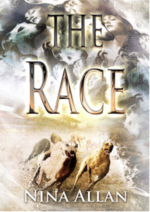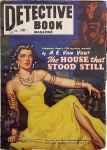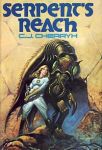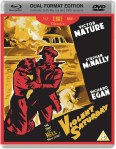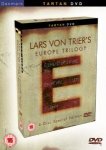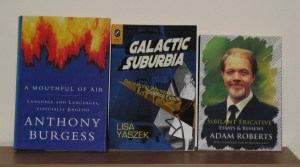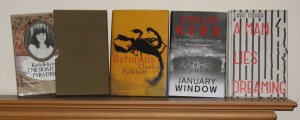The last bunch of books read in 2014… Almost. There’s one more I’m currently reading, but I’ll lead off my first reading diary post of 2015 with it. I’ll do a numbers post once the year is actually over.
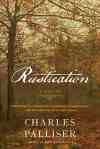 Rustication, Charles Palliser (2014) I’ve been a fan of Palliser’s works for years, but he doesn’t produce much. In fact, I thought he’d packed it in. But during this summer I’d spotted a new charity shop in town, near Fanoush, where I occasionally go for a falafel wrap at lunch-time. So one day after getting my wrap – they’re actually made with proper khubz, not stupid tortillas – I popped into the charity shop. And spotted Rustication. Result. The novel is set in 1863 over the Christmas holiday and takes the form of a journal, with anonymous letters inserted. Richard Shenstone has been rusticated from Cambridge after the suspicious death of a friend. His father died earlier in disgrace, and his near-destitute mother and sister are now living in a run-down house on the edge of a salt marsh near the town of Thurchester. Shortly after Richard’s arrival, someone starts sending obscene poison pen letters to the worthy women of the area and their daughters, and sneaking about at night and killing farm animals in horrible ways. Clues suggest Richard is responsible, although since it’s his journal which forms the narrative it’s clears it’s not him. Having said that, he does have an opium habit, which leads him to do a number of stupid things which make him look guilty. It all comes to a head when the local earl’s nephew and heir is murdered returning from an Assembly at which Richard had threatened him for compromising his sister’s honour. Rustication is pure Gothic, but tricked up as a literary thriller. It’s a slighter work than The Quincunx or Betrayals, but I’m still a fan.
Rustication, Charles Palliser (2014) I’ve been a fan of Palliser’s works for years, but he doesn’t produce much. In fact, I thought he’d packed it in. But during this summer I’d spotted a new charity shop in town, near Fanoush, where I occasionally go for a falafel wrap at lunch-time. So one day after getting my wrap – they’re actually made with proper khubz, not stupid tortillas – I popped into the charity shop. And spotted Rustication. Result. The novel is set in 1863 over the Christmas holiday and takes the form of a journal, with anonymous letters inserted. Richard Shenstone has been rusticated from Cambridge after the suspicious death of a friend. His father died earlier in disgrace, and his near-destitute mother and sister are now living in a run-down house on the edge of a salt marsh near the town of Thurchester. Shortly after Richard’s arrival, someone starts sending obscene poison pen letters to the worthy women of the area and their daughters, and sneaking about at night and killing farm animals in horrible ways. Clues suggest Richard is responsible, although since it’s his journal which forms the narrative it’s clears it’s not him. Having said that, he does have an opium habit, which leads him to do a number of stupid things which make him look guilty. It all comes to a head when the local earl’s nephew and heir is murdered returning from an Assembly at which Richard had threatened him for compromising his sister’s honour. Rustication is pure Gothic, but tricked up as a literary thriller. It’s a slighter work than The Quincunx or Betrayals, but I’m still a fan.
 The Man with the Golden Gun, Ian Fleming (1965) There’s a story that Fleming had told people he planned to become a writer once World War II ended, but one of his upper crust friends told him, “Oh Ian, don’t. You don’t have the brains for it.” And he didn’t, you know. Have the brains for it. The 007 novels, and I’ve now read them all except for Octopussy & The Living Daylights (which is on the TBR), range from bad to terrible. And The Man with the Golden Gun is toward the terrible end of the scale. Of course, the film bears no resemblance to it. (The only film which follows the plot of the novel is Thunderball, and that’s because it’s actually a novelisation of the script… and a rights battle between Fleming and four others subsequently tied up the title for decades.) In The Man with the Golden Gun the novel, Scaramanga plies his trade in the Caribbean and has links to the Castro regime. Bond has been sent after him because he returned from You Only Live Twice brainwashed by the KGB to kill M. But now he’s had electro-shock therapy and he’s back to his normal self. M is still wary, however: hence the mission to terminate Scaramanga. Either Bond will prove his mettle, or Scaramanga will get rid of an embarrassing loose end. Bond stumbles across a clue revealing that Scaramanga is in a town in Jamaica, heads there, meets the man in a brothel, and is hired as security for an upcoming meeting Scaramanga is hosting at his half-finished luxury hotel nearby, where “investors” (ie, mobsters) will be persuaded to hand over more cash to finish the hotel. Scaramanga talks like a hoodlum from a cheap television series, Bond is his usual two-dimensional self, and Fleming can’t resist getting in his usual offensive digs at homosexuality, women and non-whites. Parts of the novel simply don’t ring true at all, as if Fleming has done little or no research; the only bits that are convincing are his descriptions of the countryside (Fleming, of course, lived in Jamaica). As with the bulk of the Bond books, you’re better off sticking with the film.
The Man with the Golden Gun, Ian Fleming (1965) There’s a story that Fleming had told people he planned to become a writer once World War II ended, but one of his upper crust friends told him, “Oh Ian, don’t. You don’t have the brains for it.” And he didn’t, you know. Have the brains for it. The 007 novels, and I’ve now read them all except for Octopussy & The Living Daylights (which is on the TBR), range from bad to terrible. And The Man with the Golden Gun is toward the terrible end of the scale. Of course, the film bears no resemblance to it. (The only film which follows the plot of the novel is Thunderball, and that’s because it’s actually a novelisation of the script… and a rights battle between Fleming and four others subsequently tied up the title for decades.) In The Man with the Golden Gun the novel, Scaramanga plies his trade in the Caribbean and has links to the Castro regime. Bond has been sent after him because he returned from You Only Live Twice brainwashed by the KGB to kill M. But now he’s had electro-shock therapy and he’s back to his normal self. M is still wary, however: hence the mission to terminate Scaramanga. Either Bond will prove his mettle, or Scaramanga will get rid of an embarrassing loose end. Bond stumbles across a clue revealing that Scaramanga is in a town in Jamaica, heads there, meets the man in a brothel, and is hired as security for an upcoming meeting Scaramanga is hosting at his half-finished luxury hotel nearby, where “investors” (ie, mobsters) will be persuaded to hand over more cash to finish the hotel. Scaramanga talks like a hoodlum from a cheap television series, Bond is his usual two-dimensional self, and Fleming can’t resist getting in his usual offensive digs at homosexuality, women and non-whites. Parts of the novel simply don’t ring true at all, as if Fleming has done little or no research; the only bits that are convincing are his descriptions of the countryside (Fleming, of course, lived in Jamaica). As with the bulk of the Bond books, you’re better off sticking with the film.
 Langue[dot]doc 1305, Gillian Polack (2014) A team of scientists have been sent back in time to the titular place and time, and they have a single historian with them – who was parachuted in at the last minute after the original two historian members of the team pulled out. Artemisia Wormwood, however, is not an expert on 14th-century Languedoc, but on mediaeval saints. Fortunately, she knows considerably more about the time and place than the scientists, who are there to refine their theory of time travel and investigate the natural environment. The team set up in a system of caves under a hill beside the village of St-Guilhelm-le-Désert and, while they keep apart from the villagers (only Wormwood speaks old French, and she does that haltingly), they make no secret of their presence. In fact, the scientists behave like a bunch of spoilt kids. They don’t seem to care about the impact they may be having on the lives of those in the village. Wormwood acts as an unofficial liaison between the two groups, via disgraced knight Guilhelm. This one is definitely a slow-burner. Not much happens during the course of the novel, it’s more a diary of incidents experienced by the time team. However, it definitely packs a sting in the tail. The prose is polished, Polack evokes her period extremely well, and the whole thing is very readable if somewhat languidly paced. I thoroughly enjoyed it.
Langue[dot]doc 1305, Gillian Polack (2014) A team of scientists have been sent back in time to the titular place and time, and they have a single historian with them – who was parachuted in at the last minute after the original two historian members of the team pulled out. Artemisia Wormwood, however, is not an expert on 14th-century Languedoc, but on mediaeval saints. Fortunately, she knows considerably more about the time and place than the scientists, who are there to refine their theory of time travel and investigate the natural environment. The team set up in a system of caves under a hill beside the village of St-Guilhelm-le-Désert and, while they keep apart from the villagers (only Wormwood speaks old French, and she does that haltingly), they make no secret of their presence. In fact, the scientists behave like a bunch of spoilt kids. They don’t seem to care about the impact they may be having on the lives of those in the village. Wormwood acts as an unofficial liaison between the two groups, via disgraced knight Guilhelm. This one is definitely a slow-burner. Not much happens during the course of the novel, it’s more a diary of incidents experienced by the time team. However, it definitely packs a sting in the tail. The prose is polished, Polack evokes her period extremely well, and the whole thing is very readable if somewhat languidly paced. I thoroughly enjoyed it.
The Race, Nina Allan (2014) Allan’s first novel-length piece of fiction is actually four linked novellas, and also very lightly meta-fictional. I wrote about it here.
From the Legend of Biel, Mary Staton (1975). This was the first book of the second series of Ace Specials. I read it for SF Mistressworks. My review is here.
The Moon King, Neil Williamson (2014). I’m working on a longer review of this, so I’ll just mention it in passing here. I will say, however, that I enjoyed it much more than I had expected to. (I’ve known Neil for ages, so I expected it to be well-written, but had thought it wouldn’t be quite to my taste – I was wrong.) Anyway, a post on this novel should appear here soon-ish.
 The First Fifteen Lives of Harry August, Claire North (2014). Found this in a charity shop, had heard it mentioned here and there, understood it to be not unlike Kate Atkinson’s Life After Life (which I thought good), so decided to give it a go. And yes, I did enjoy it. The prose is nice and breezy, the central premise – people who relive their lives over and over again – was handled quite cleverly, and the eponymous protagonist was sympathetic and plausible. Plot-wise, the book is less successful – although hinted at on the first page, the plot didn’t actually kick into gear until over halfway in, and even then it spent more time on the silly maguffin at the core of the book than it did the far more interesting process by which the villain removed all his enemies. I’d seen mention of North’s Touch, due out early in 2015, and thought it might be worth a go. On the strength of The First Fifteen Lives of Harry August, I’ll almost certainly be picking up a copy.
The First Fifteen Lives of Harry August, Claire North (2014). Found this in a charity shop, had heard it mentioned here and there, understood it to be not unlike Kate Atkinson’s Life After Life (which I thought good), so decided to give it a go. And yes, I did enjoy it. The prose is nice and breezy, the central premise – people who relive their lives over and over again – was handled quite cleverly, and the eponymous protagonist was sympathetic and plausible. Plot-wise, the book is less successful – although hinted at on the first page, the plot didn’t actually kick into gear until over halfway in, and even then it spent more time on the silly maguffin at the core of the book than it did the far more interesting process by which the villain removed all his enemies. I’d seen mention of North’s Touch, due out early in 2015, and thought it might be worth a go. On the strength of The First Fifteen Lives of Harry August, I’ll almost certainly be picking up a copy.
 The Casebook of Victor Frankenstein, Peter Ackroyd (2008). Victor Frankenstein, a young man from Switzerland, joins Oxford University, where he meets Percy Bysshe Shelley. The two become friends, although their interests only just coincide – Frankenstein wants to understand how life is created, and focuses his investigations on reanimating dead bodies using “the electrical fluid”, whereas Shelley’s investigations are more metaphysical. Even after Shelley is expelled, the two remain close – Frankenstein even moves to London to be near him. In order to further experiment, Frankenstein contacts some “resurrection men” and has them deliver cadavers to his laboratory in Limehouse. Most of his experiments are failures, but when he is handed the body of Jack Keat, a few short hours after he committed suicide (he was dying of consumption), Frankenstein successfully brings him back to life… And you just know the story going to end up at the Villa Diodati. Ackroyd takes a few liberties with Shelley’s life, and Byron comes across as a dickhead, but the whole adds up to an entertaining take on the Frankenstein story and the Romantic poets. The period detail is impressively handled, Frankenstein is a sympathetic narrator, and there are a number of neat touches to the scientific thought of the day which I found amusing. A good book.
The Casebook of Victor Frankenstein, Peter Ackroyd (2008). Victor Frankenstein, a young man from Switzerland, joins Oxford University, where he meets Percy Bysshe Shelley. The two become friends, although their interests only just coincide – Frankenstein wants to understand how life is created, and focuses his investigations on reanimating dead bodies using “the electrical fluid”, whereas Shelley’s investigations are more metaphysical. Even after Shelley is expelled, the two remain close – Frankenstein even moves to London to be near him. In order to further experiment, Frankenstein contacts some “resurrection men” and has them deliver cadavers to his laboratory in Limehouse. Most of his experiments are failures, but when he is handed the body of Jack Keat, a few short hours after he committed suicide (he was dying of consumption), Frankenstein successfully brings him back to life… And you just know the story going to end up at the Villa Diodati. Ackroyd takes a few liberties with Shelley’s life, and Byron comes across as a dickhead, but the whole adds up to an entertaining take on the Frankenstein story and the Romantic poets. The period detail is impressively handled, Frankenstein is a sympathetic narrator, and there are a number of neat touches to the scientific thought of the day which I found amusing. A good book.
 The Female of the Species, Carol Joyce Oates (2006). My second Oates. This one is a collection of short stories, many of which originally appeared in genre magazines. I think I can safely say now that Oates doesn’t quite work for me. According to the blurb, in these stories “women are confronted by the evil around them and surprised by the evil they find within them”. I thought the most successful story was ‘Madison at Guignol’, in which a trophy wife polished to a lacquer-like gloss learns of a secret door at one of her favourite high-end boutiques and insists on admittance through it: Fifth Avenue meets Gothic horror. Another one I liked was ‘Hunger’, a much longer piece about a bored wife who, after a holiday affair with a younger man, is horrified when he turns up at her home. Even though she loves him – though it seems to be more of a passion – she’s not willing to jeopardise her marriage. Not all of the stories worked for me – the one about the nurse felt too much like reportage, in some of the others the prose seemed too focused on effect rather than the story. The reason for Oates’ stature is plain to see in this collection, but there are other writers I’d sooner read.
The Female of the Species, Carol Joyce Oates (2006). My second Oates. This one is a collection of short stories, many of which originally appeared in genre magazines. I think I can safely say now that Oates doesn’t quite work for me. According to the blurb, in these stories “women are confronted by the evil around them and surprised by the evil they find within them”. I thought the most successful story was ‘Madison at Guignol’, in which a trophy wife polished to a lacquer-like gloss learns of a secret door at one of her favourite high-end boutiques and insists on admittance through it: Fifth Avenue meets Gothic horror. Another one I liked was ‘Hunger’, a much longer piece about a bored wife who, after a holiday affair with a younger man, is horrified when he turns up at her home. Even though she loves him – though it seems to be more of a passion – she’s not willing to jeopardise her marriage. Not all of the stories worked for me – the one about the nurse felt too much like reportage, in some of the others the prose seemed too focused on effect rather than the story. The reason for Oates’ stature is plain to see in this collection, but there are other writers I’d sooner read.
 The Martian, Andy Weir (2014). This is an odd one. The book has been hugely successful, so much so Ridley Scott is apparently making a film of it. Yet most of the praise for the book I’ve seen has been outside fandom. Is this because the book was originally self-published, and did so well on Kindle it was then picked up by a major imprint? Or is it that hard science fiction has fallen out of favour with genre fandom? Actually, I think it’s neither, but rather the fact that a) The Martian is a resolutely commercial book, and in style and approach has more in common with technothrillers than it does science fiction novels, b) it is completely hollow, there’s no meaty idea for a sf reader to get their teeth into, and c) it’s actually not very good, just pages and pages of a very irritating narrator explaining how he managed to survive on Mars after accidentally being left behind. It’s basically “Home Alone on the Red Planet”, with the planet itself playing the part of the inept burglars. (Sticking Val Kilmer, or his lookalike, on the cover, probably didn’t harm its chances either.) The original self-published novel has been padded out with scenes set at NASA, as they learn the narrator, Mark Watney, is still alive and then set about putting together a rescue plan. But the characterisation is paper-thin and everyone sounds pretty much the same. Watney’s various predicaments are interesting, and some of his solutions are mildly clever – but Weir throws so much bad luck at him, it soon beggars belief. We also get little real idea of what it would be like to be on the surface of Mars. A handful of mentions of the 0.4G, no mention at all of the surface radiation, but lots about the cold. Lots. It was also my understanding that at such low atmospheric pressures, gale-force winds would actually cause very little damage. The Martian could have taken place pretty much anywhere, even the Antarctic, and very little would need to change (well, the technology would have to be dialled down a little). I’m completely mystified by all the praise this book has been receiving. We might as well claim Clive Cussler’s latest sweatshop effort is one of the best sf novels of the year…
The Martian, Andy Weir (2014). This is an odd one. The book has been hugely successful, so much so Ridley Scott is apparently making a film of it. Yet most of the praise for the book I’ve seen has been outside fandom. Is this because the book was originally self-published, and did so well on Kindle it was then picked up by a major imprint? Or is it that hard science fiction has fallen out of favour with genre fandom? Actually, I think it’s neither, but rather the fact that a) The Martian is a resolutely commercial book, and in style and approach has more in common with technothrillers than it does science fiction novels, b) it is completely hollow, there’s no meaty idea for a sf reader to get their teeth into, and c) it’s actually not very good, just pages and pages of a very irritating narrator explaining how he managed to survive on Mars after accidentally being left behind. It’s basically “Home Alone on the Red Planet”, with the planet itself playing the part of the inept burglars. (Sticking Val Kilmer, or his lookalike, on the cover, probably didn’t harm its chances either.) The original self-published novel has been padded out with scenes set at NASA, as they learn the narrator, Mark Watney, is still alive and then set about putting together a rescue plan. But the characterisation is paper-thin and everyone sounds pretty much the same. Watney’s various predicaments are interesting, and some of his solutions are mildly clever – but Weir throws so much bad luck at him, it soon beggars belief. We also get little real idea of what it would be like to be on the surface of Mars. A handful of mentions of the 0.4G, no mention at all of the surface radiation, but lots about the cold. Lots. It was also my understanding that at such low atmospheric pressures, gale-force winds would actually cause very little damage. The Martian could have taken place pretty much anywhere, even the Antarctic, and very little would need to change (well, the technology would have to be dialled down a little). I’m completely mystified by all the praise this book has been receiving. We might as well claim Clive Cussler’s latest sweatshop effort is one of the best sf novels of the year…

